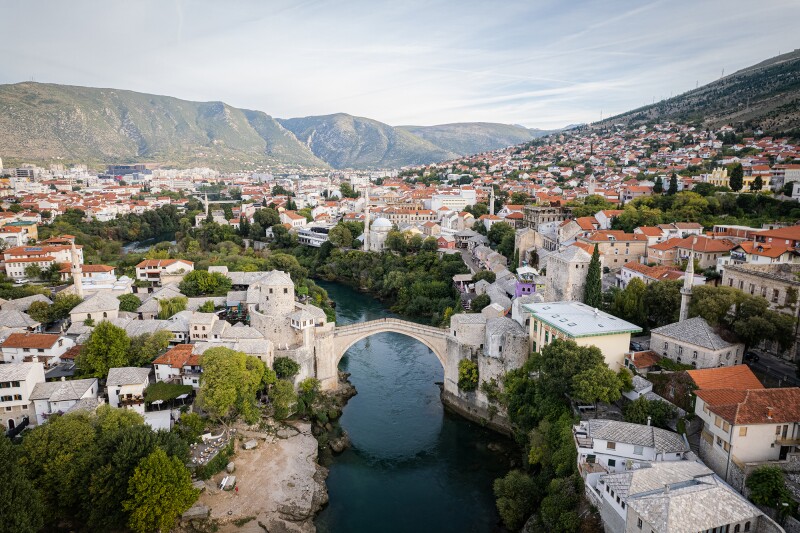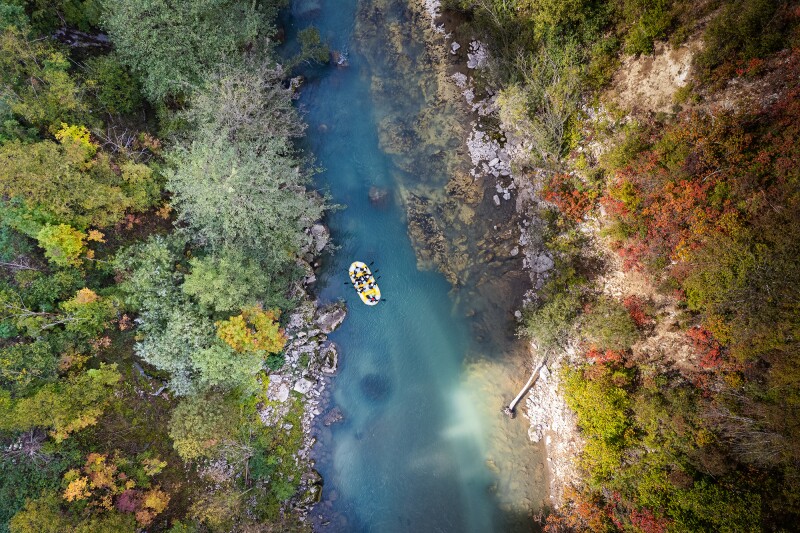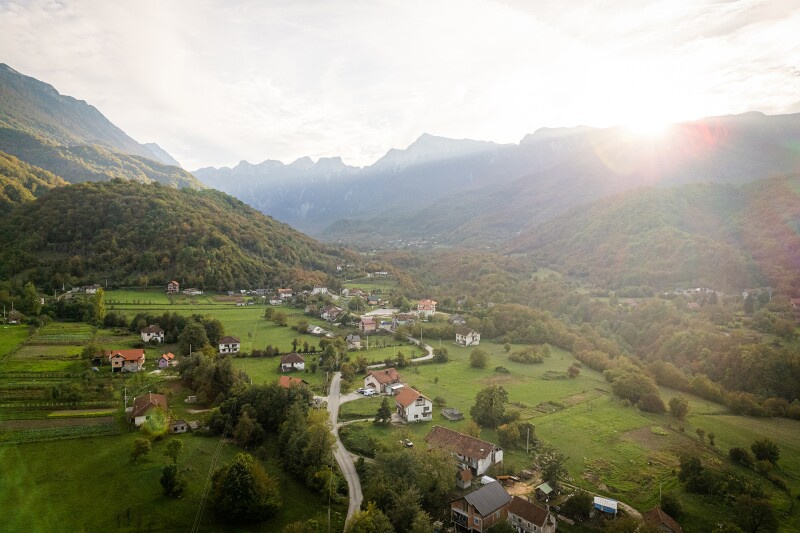As the setting sun turns the city of Mostar in Bosnia and Herzegovina golden, I walk across the Stari Most, or Old Bridge, which arcs over the turquoise Neretva River. I watch as young couples line up winetastings along the bridge walls and riverside restaurant patios serve plates of cevapi (lamb kababs with somun, Bosnian pita bread) against a backdrop of green mountains and spindly minarets. The call to prayer echoes across the water.
It’s hard to imagine that everything I’m looking at, including the 16th-century Ottoman bridge, was destroyed in the 1990s conflict that devastated the country. The bridge and surrounding Old Town were rebuilt over five years under an international effort that began in 1999 and were declared a UNESCO World Heritage site in 2005. Stari Most stands as a symbol of reconciliation, but in a country composed of two separate federal entities—the Federation of Bosnia and Herzegovina and the Republic of Srpska—with a decentralized government led by a tripartite presidency, a peaceful climate isn’t always the reality. The ethno-religious divisions among Orthodox Christian Serbs, Catholic Croats, and Muslim Bosniaks that dominated the war still run deep in certain regions. While understanding that this legacy of conflict is important, the country’s younger generation is keen to move on—and a new tourism initiative might help.

The Old Bridge and Old City of Mostar were declared a UNESCO World Heritage site in 2005.
Courtesy of Annapurna Mellor / Intrepid
I’ve come here with tour operator Intrepid, which launched its Bosnia and Herzegovina Expedition this June, part of a five-year, $20-million project called Turizam, led by international development agency USAID. The aim is to use sustainable, community- and nature-based tourism to foster economic stability and social harmony, addressing issues such as high youth emigration and low participation of women in the workforce. The initiative includes financial support for businesses and industry training and the development of experiences that unite disparate parts of the country, like the Herzegovina Wine Route.
The project looks promising: In 2019, prepandemic slump, the country had the third-highest tourism growth rate in the world, and so far, 2023 marks tourism’s highest-grossing year yet. While Mostar is by far the most popular stop for travelers, I venture much deeper. “Most people see Mostar and then they move on to Croatia or somewhere else,” says our Intrepid tour guide Elsa Lojic. “For once I have a chance to lead a trip entirely in my country; it means a lot to me.”
The Intrepid trip begins in Lojic’s hometown of Sarajevo, the capital of Bosnia and Herzegovina, in a valley along the Miljacka River in the southwest of the country. There, our group of travelers gather for dinner in the rolling hills high above the city at the home of Mersiha and Mustafa. The couple launched their business, Bosnian Cooking Lessons, out of their kitchen in 2018, offering visitors a look at traditional Bosnian food through both hosted dinners and hands-on cooking classes. Through its partnership with USAID, Intrepid worked entirely with small, locally owned businesses like this one to create the trip itinerary, ensuring travelers’ dollars go where it counts. “We grew up in this neighborhood and now this is a way to share our home and our culture,” says Mustafa. Beside him, Mersiha shows us how she rolls out dough for burek—pastries stuffed with spinach and cheese or lamb—into a paper-thin layer on the table. Later, we savor the miniature pies along with hot, bubbling platters of peppers, onion, and cabbage filled with minced meat. Outside, night blots out the city’s red roofs, replaced by a sea of winking lights.

Bosnia and Herzegovina also offers a variety of outdoor adventures.
Courtesy of Annapurna Mellor / Intrepid
From Sarajevo, our small van drives north, a tapestry of forest, tumbling rivers, and the peaks of the Dinaric Alps unfurling outside the window. Arriving in the mountainous town of Jajce, we check into Konoba Slapovi, a locally owned hotel and restaurant ensconced in a storybook setting of trees and terraced waterfalls. Jajce is the birthplace of modern Yugoslavia—antifascist leaders from across the Balkans led by communist revolutionary Tito met here during World War II, forming the Federal Republic of Yugoslavia. It still attracts partisan tourists nostalgic for Tito’s era. However, there’s the promise of a different kind of tourism here, too.
A walk through town brings us to the 14th-century Jajce Fortress and the stone vestiges of St. Mary’s Church, the country’s oldest Catholic church. The church was later used as a mosque under Ottoman rule and today is an emblem of political strife, as Croats and Bosniaks argue over ownership. But the church also embodies a potential solution to this ethno-religious animosity: It’s part of a multicultural architectural heritage that’s up for UNESCO status and holds the potential to foster a spirit of unity instead of division. In smaller cities like Jajce, where schools are still segregated and it’s taboo to marry outside your religious group, the hope is that UNESCO status might create a feeling of collective ownership over cultural heritage, one that celebrates the diverse religious architecture in the city—from mosques and churches to a Mithraic temple—a reminder to the community of the strength and beauty in diversity. With the increased tourism that would come with UNESCO status, locals might also come to see the economic value in shifting the tide toward tolerance and a more multicultural identity.
“This is a place where world religions could be presented to young generations to show how we can live in harmony,” says our guide in the city, 32-year-old Dragan Glavas. “Tourism based on this heritage can remind us that we’ve lived in a mixed culture for hundreds of years and teach us to learn from each other,” adds Glavas. It’s a sentiment that’s echoed by the people who welcome us into their homes and villages throughout the trip, whether that’s over a slice of homemade fig cake in Stolac, the country’s oldest city, or a traditional alfresco dinner in the less-traveled city of Konjic. Just outside the latter, travelers can visit Tito’s bunker, a top-secret, Cold War–era nuclear bunker and military command center. In 2011, the sprawling underground fortress was opened to the public as an exhibition space for modern art and now offers guided tours.
Stops at lesser-known villages are part of Tourizam’s Most Beautiful Villages concept, an effort to bolster rural tourism. Along that route is the town of Blagaj, where we visit the 15th-century Blagaj Tekke, a snow-white Dervish monastery that stands in relief against a cliff face, the Buna River rushing alongside it. It’s long been a pilgrimage site for believers, poets, and explorers and the building embodies the sect’s mysticism. Inside, I walk across threadbare ruby carpets, gaze up at a starry, stained-glass dome in a small hammam, and thumb through dog-eared copies of the Qur’an that sit on burnished wood shelves.

Hiking, white-water rafting, and climbing are all options amid Bosnia and Herzegovina’s striking scenery.
Courtesy of Annapurna Mellor / Intrepid
The potential for sustainable adventure tourism
There’s no doubt that Bosnia and Herzegovina is culturally rich, but it has serious potential for adventure tourism, too. The landscape is still 65 percent forested and threaded with countless rivers and mountains, attracting white-water enthusiasts and climbers. A new via ferrata just opened, and some of the most scenic stretches of the Balkans’ 1,250-mile Via Dinarica hiking trail run through the country. This is encouraging organizations like the Adventure Travel Trade Association to get involved in the Turizam project.
By developing ecotourism here, USAID hopes to expand protected natural areas (only 1 percent of the country’s territory is covered by legally protected forests, and river ecosystems are at risk because of dam development) nudging political leaders away from extractive industries to recognize the value of protecting this natural heritage, something environmental advocates are already doing. Researchers are currently at work to prove the ecological value of the upper Neretva River, which is currently threatened by 70 proposed dams; in 2021, a Bosnian woman, Maida Bilal, was awarded the Goldman Environmental Prize for protecting the Kruščica River.
Although our day of white-water rafting on the Neretva River near Konjac is thwarted by bad weather, we embark on a different adventure in the southwest. The landscape here turns arid and open, with yellow wildflowers sprinkled through fields dotted with small knots of houses. Our group clambers into a 4x4 Jeep and climbs a rutted dirt road high above the town of Livno. On the Kruzi plateau, where a windswept landscape of scrub and craggy rock stretches toward the foothills of Mount Cincar, we roll to a stop. Before us, dozens of wild horses graze and canter beside their colts, flicking their manes in the lemon sunshine.
These hills were once used for farming, but now more than 700 horses roam here, and tour company Continental Adventure gets visitors up close to them on its Wild Horses Safari. Founder Marin Mamuza left Bosnia as a teenager to study in Croatia, but the potential he saw in this business brought him home. “Brain drain is a big problem in Bosnia, but tourism gives young people a reason to come back, vote differently than past generations; that’s how things will change,” says Lojic.
The area we’re standing in marked the fighting line between Croat and Serb forces during the war, and the era’s ghosts haunt the hills: Red and white posts in the distance mark mine fields—unmarked and unexploded landmines still pose a risk in a small percentage of rural and remote areas, making it important to explore with a knowledgeable guide—and an imposing white cross stands like an enormous grave marker on a hilltop to commemorate Croat lives lost. Even so, 30 years later, there is the promise of a different future here. There’s hope.
This picturesque plateau is where Mamuza asked his Croatian wife to marry him, he told me. “I want to remember this place for love, not war.”











